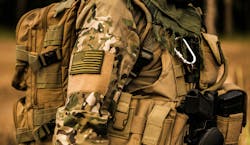U.S. Army Awards Contract to Create Lighter and More Durable Batteries for Combat Troops
Today’s soldiers carry a heavy load, literally and figuratively. In addition to the challenges that come with keeping the U.S. and its interests safe around the world, the modern soldier adds anywhere between 60 to 120 pounds of gear, body armor and weapons to his or her frame on a combat mission.
That can include upward of 20 pounds of lithium-ion battery packs to power mission-critical equipment such as night vision goggles.
Extreme temperatures and physical damage can degrade a battery’s performance so, in the spirit of better safe than sorry, troops carry multiple backups.
The U.S. Army Combat Capabilities Development Command C5ISR Center (DEVCOM) is looking for ways to lighten the load, without compromising safety. To that end, DEVCOM has awarded a $6.4 million contract to NanoGraf and South 8 Partners to develop higher energy, safer and lighter batteries for combat troops.
NanoGraf is an advanced battery material company that was spun out of Northwestern University and Argonne National Laboratory. South 8 Partners is the creator of LiGas, a liquefied gas electrolyte that improves energy performance, charging speed and safety of advanced lithium-ion batteries.
“With thousands of DOD systems in the field, today’s successful and safe military operations require long-lasting, versatile battery technology,” said José Collazo-Castillo, project lead, supply resiliency for soldier power at the DEVCOM C5ISR Center.
Lighter, faster, more durable
The contract is part of the Defense Innovation Unit (DIU)’s Family of Advanced Standard Batteries initiative. DIU is also funding research on long-duration energy storage systems on bases in New York and Missouri.
NanoGraf and South 8 will develop a high-rate injection system that leverages South 8’s LiGas technology and NanoGraf’s 3.8 Ah 18650 lithium-ion cell. The 18650 cell design looks very similar to an AA alkaline battery.
The result is expected to be a rugged, lighter weight prototype that charges faster than traditional lithium-ion batteries and eliminates the risk of catastrophic failure if the battery were to be exposed to extreme temperatures or damaged during an operation.
“While today’s lithium-ion batteries struggle with poor capacity in difficult climates, our LiGas electrolyte directly addresses significant pain points by enhancing range and performance in extreme environments, while minimizing fire risk during critical missions,” said Tom Stepien, CEO of South 8.
Supply chain security also a goal
The partnership is also designed to bolster domestic production of cylindrical lithium-ion batteries in North America, reducing supply chain risks.
The U.S. currently sources the majority of its lithium-ion batteries from China.
“We are committed to advancing battery innovation and helping to build a more resilient battery supply chain,” said Dr. Francis Wang, CEO of NanoGraf. “Adding the safety and extreme temperature capabilities of South 8’s LiGas electrolyte to our silicon anode 18650 cells has the potential to yield a powerful product with unique benefits compared to other commercial cells.”
Collazo-Castillo said DEVCOM is hopeful that the combined technologies can “help the U.S. build and produce higher performing, cross-compatible battery cell technology and help fortify the supply chain for the future of national security.”
About the Author
Kathy Hitchens
Special Projects Editor
I work as a writer and special projects editor for Microgrid Knowledge. I have over 30 years of writing experience, working with a variety of companies in the renewable energy, electric vehicle and utility sector, as well as those in the entertainment, education, and financial industries. I have a BFA in Media Arts from the University of Arizona and a MBA from the University of Denver.

